Australian Economy Analysis 2016
VerifiedAdded on 2020/03/23
|19
|3711
|112
AI Summary
This assignment requires an in-depth analysis of the Australian economy in 2016. Students must utilize various financial ratios, economic data (like GDP), and reports from sources like the Reserve Bank of Australia and Australian Energy Update to evaluate key economic indicators and trends. The analysis should consider factors influencing the Australian dollar, consumer spending, and overall economic performance.
Contribute Materials
Your contribution can guide someone’s learning journey. Share your
documents today.
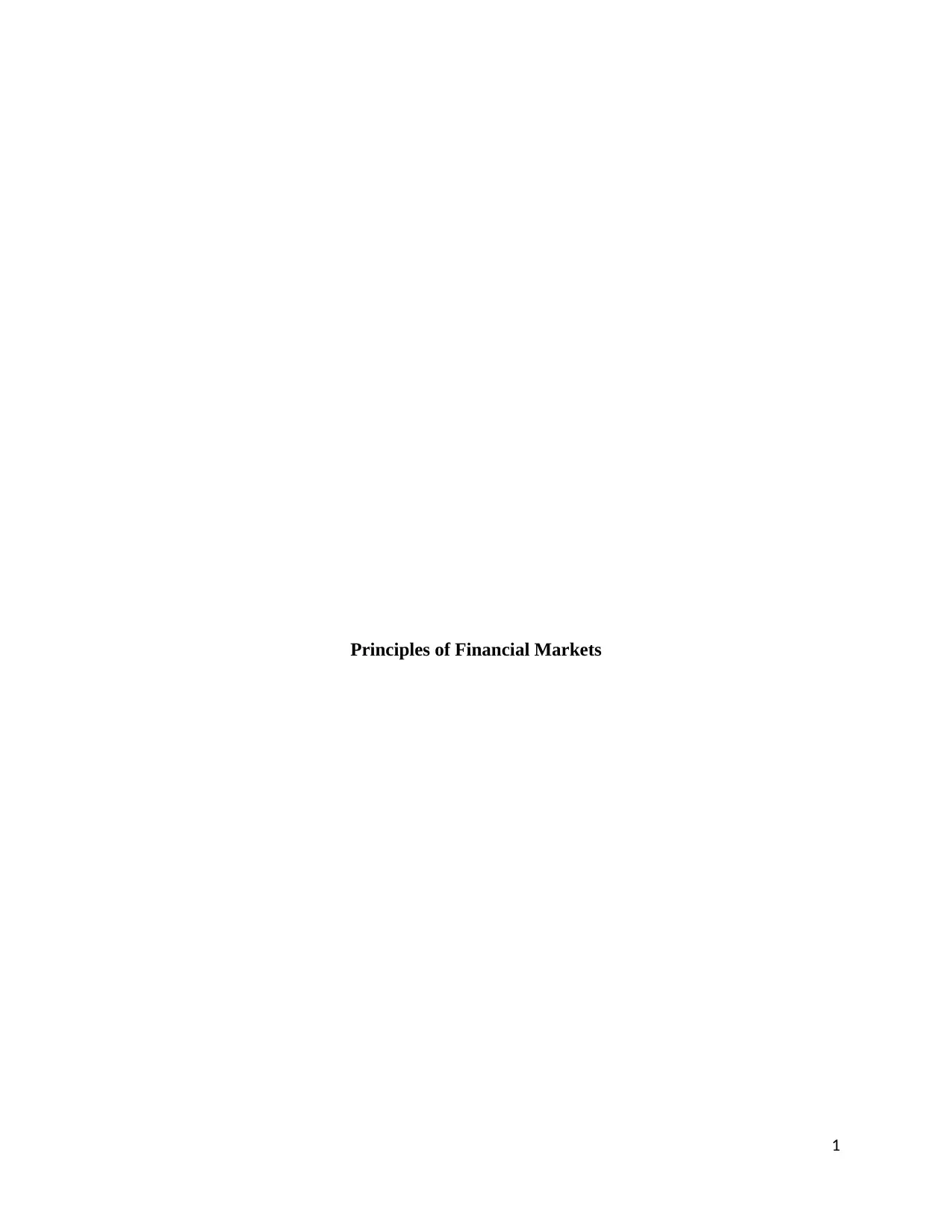
Principles of Financial Markets
1
1
Secure Best Marks with AI Grader
Need help grading? Try our AI Grader for instant feedback on your assignments.
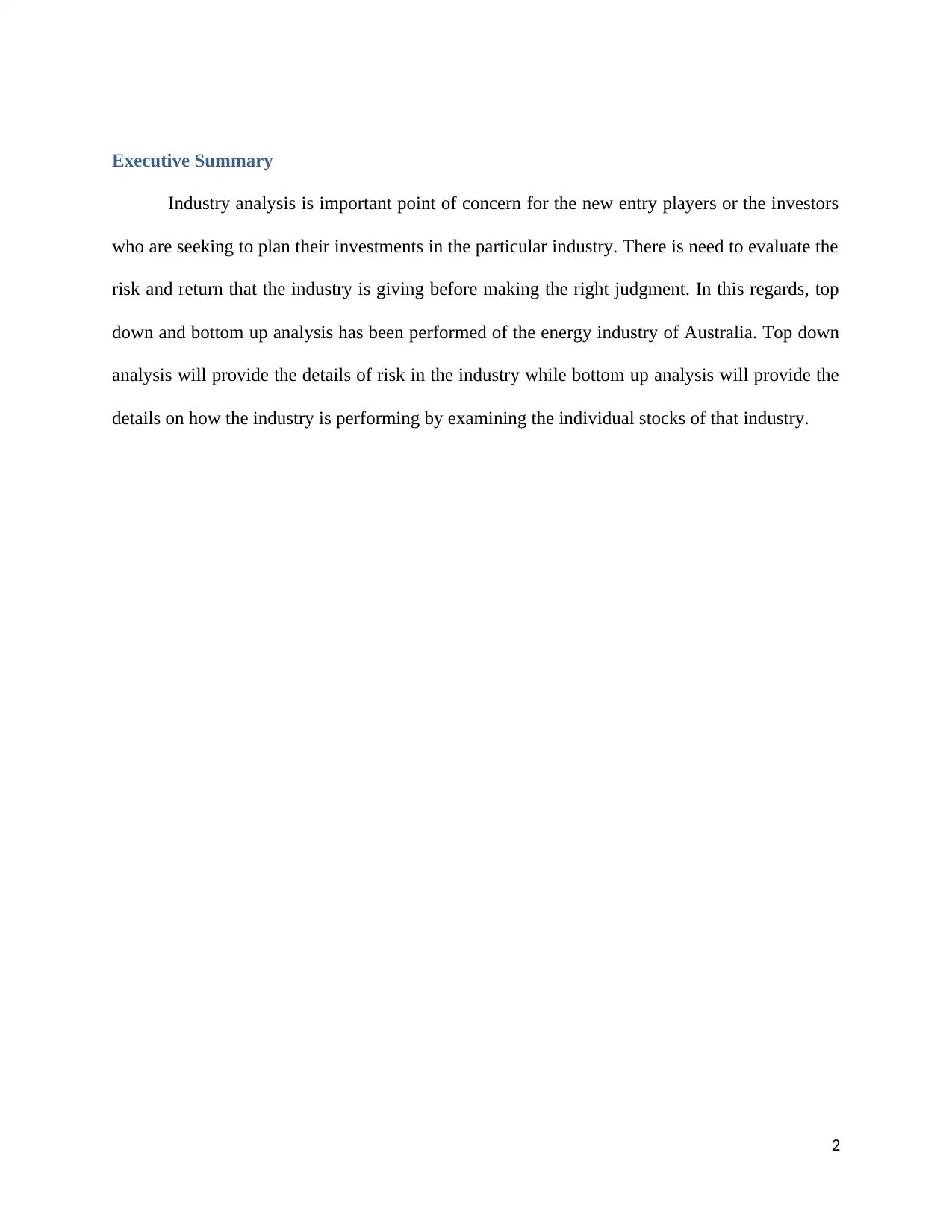
Executive Summary
Industry analysis is important point of concern for the new entry players or the investors
who are seeking to plan their investments in the particular industry. There is need to evaluate the
risk and return that the industry is giving before making the right judgment. In this regards, top
down and bottom up analysis has been performed of the energy industry of Australia. Top down
analysis will provide the details of risk in the industry while bottom up analysis will provide the
details on how the industry is performing by examining the individual stocks of that industry.
2
Industry analysis is important point of concern for the new entry players or the investors
who are seeking to plan their investments in the particular industry. There is need to evaluate the
risk and return that the industry is giving before making the right judgment. In this regards, top
down and bottom up analysis has been performed of the energy industry of Australia. Top down
analysis will provide the details of risk in the industry while bottom up analysis will provide the
details on how the industry is performing by examining the individual stocks of that industry.
2
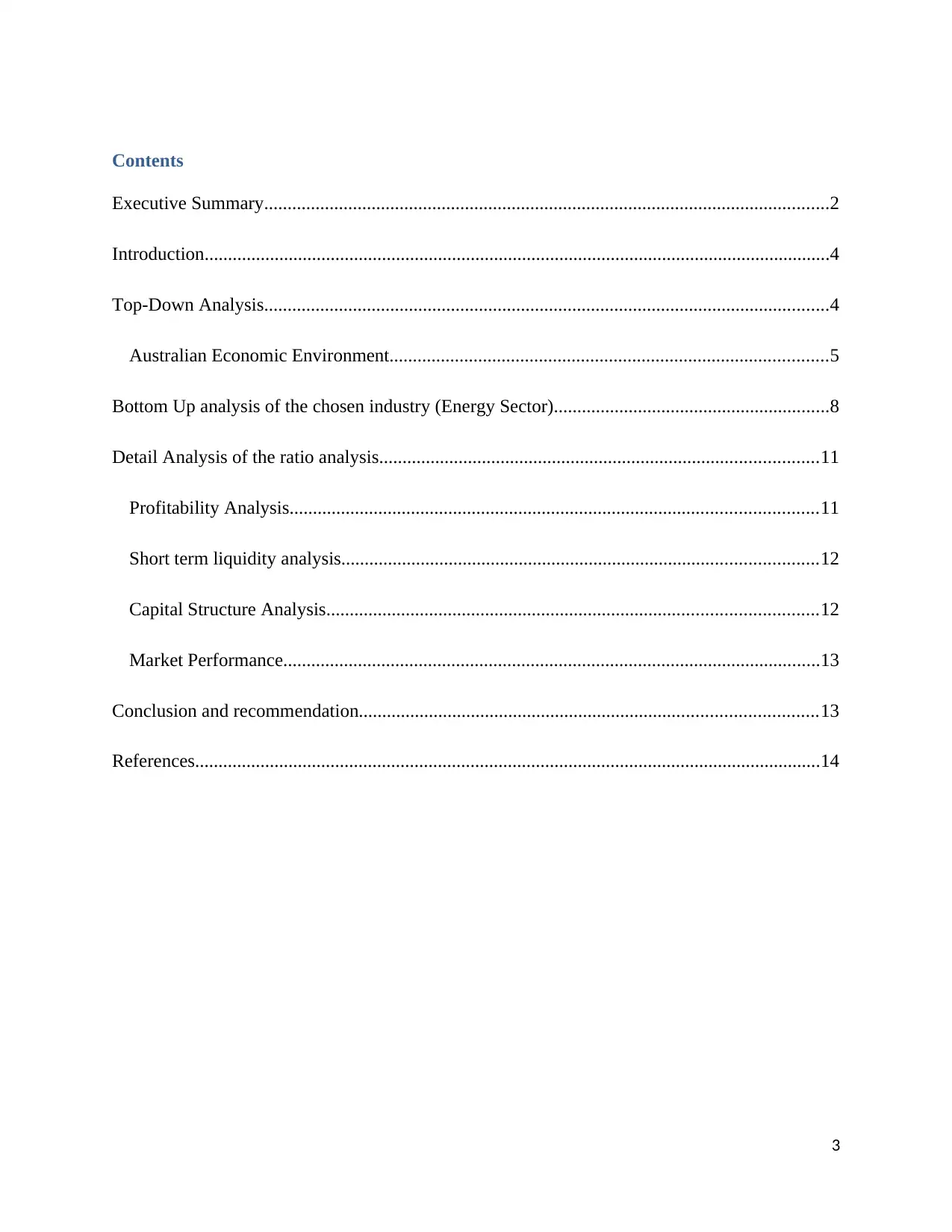
Contents
Executive Summary.........................................................................................................................2
Introduction......................................................................................................................................4
Top-Down Analysis.........................................................................................................................4
Australian Economic Environment..............................................................................................5
Bottom Up analysis of the chosen industry (Energy Sector)...........................................................8
Detail Analysis of the ratio analysis..............................................................................................11
Profitability Analysis.................................................................................................................11
Short term liquidity analysis......................................................................................................12
Capital Structure Analysis.........................................................................................................12
Market Performance...................................................................................................................13
Conclusion and recommendation..................................................................................................13
References......................................................................................................................................14
3
Executive Summary.........................................................................................................................2
Introduction......................................................................................................................................4
Top-Down Analysis.........................................................................................................................4
Australian Economic Environment..............................................................................................5
Bottom Up analysis of the chosen industry (Energy Sector)...........................................................8
Detail Analysis of the ratio analysis..............................................................................................11
Profitability Analysis.................................................................................................................11
Short term liquidity analysis......................................................................................................12
Capital Structure Analysis.........................................................................................................12
Market Performance...................................................................................................................13
Conclusion and recommendation..................................................................................................13
References......................................................................................................................................14
3
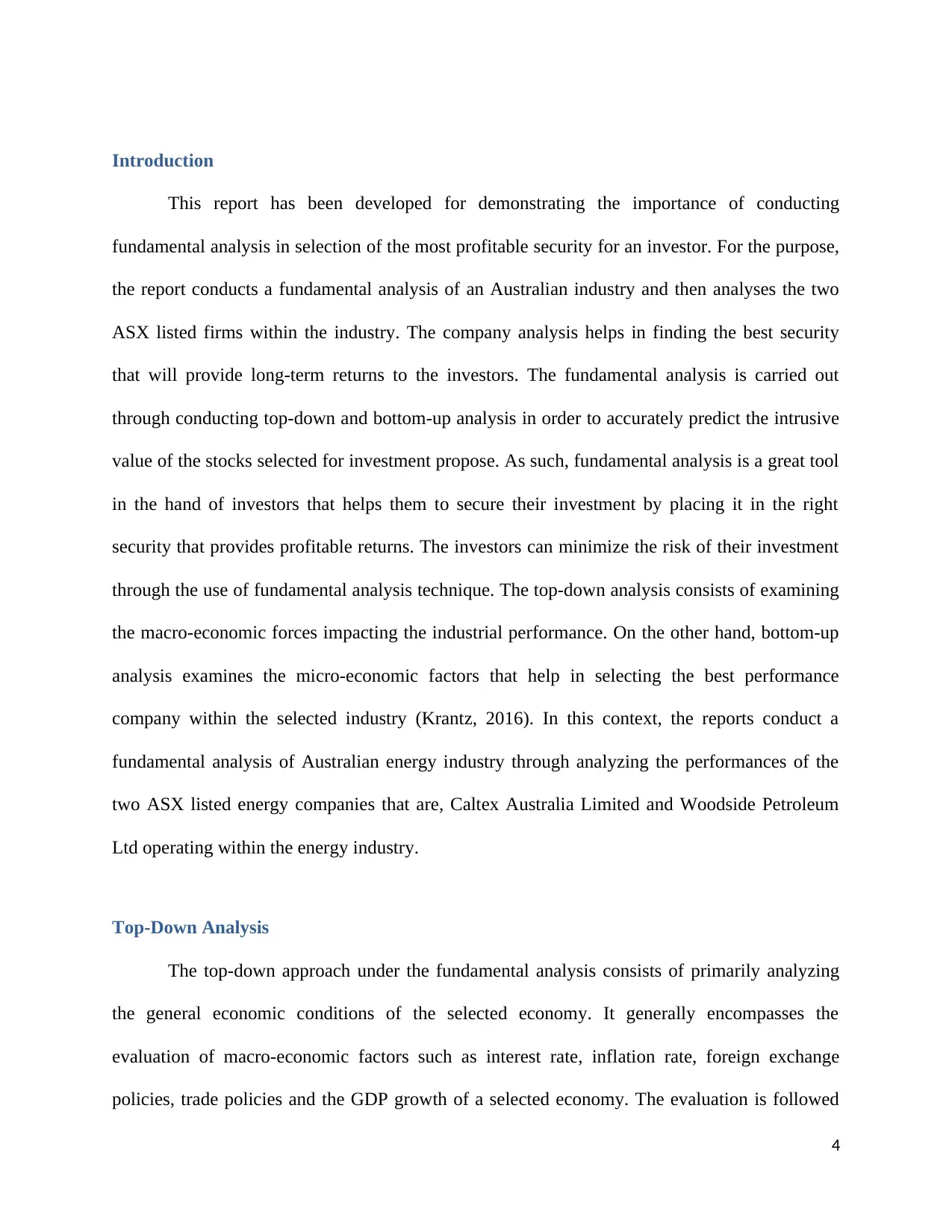
Introduction
This report has been developed for demonstrating the importance of conducting
fundamental analysis in selection of the most profitable security for an investor. For the purpose,
the report conducts a fundamental analysis of an Australian industry and then analyses the two
ASX listed firms within the industry. The company analysis helps in finding the best security
that will provide long-term returns to the investors. The fundamental analysis is carried out
through conducting top-down and bottom-up analysis in order to accurately predict the intrusive
value of the stocks selected for investment propose. As such, fundamental analysis is a great tool
in the hand of investors that helps them to secure their investment by placing it in the right
security that provides profitable returns. The investors can minimize the risk of their investment
through the use of fundamental analysis technique. The top-down analysis consists of examining
the macro-economic forces impacting the industrial performance. On the other hand, bottom-up
analysis examines the micro-economic factors that help in selecting the best performance
company within the selected industry (Krantz, 2016). In this context, the reports conduct a
fundamental analysis of Australian energy industry through analyzing the performances of the
two ASX listed energy companies that are, Caltex Australia Limited and Woodside Petroleum
Ltd operating within the energy industry.
Top-Down Analysis
The top-down approach under the fundamental analysis consists of primarily analyzing
the general economic conditions of the selected economy. It generally encompasses the
evaluation of macro-economic factors such as interest rate, inflation rate, foreign exchange
policies, trade policies and the GDP growth of a selected economy. The evaluation is followed
4
This report has been developed for demonstrating the importance of conducting
fundamental analysis in selection of the most profitable security for an investor. For the purpose,
the report conducts a fundamental analysis of an Australian industry and then analyses the two
ASX listed firms within the industry. The company analysis helps in finding the best security
that will provide long-term returns to the investors. The fundamental analysis is carried out
through conducting top-down and bottom-up analysis in order to accurately predict the intrusive
value of the stocks selected for investment propose. As such, fundamental analysis is a great tool
in the hand of investors that helps them to secure their investment by placing it in the right
security that provides profitable returns. The investors can minimize the risk of their investment
through the use of fundamental analysis technique. The top-down analysis consists of examining
the macro-economic forces impacting the industrial performance. On the other hand, bottom-up
analysis examines the micro-economic factors that help in selecting the best performance
company within the selected industry (Krantz, 2016). In this context, the reports conduct a
fundamental analysis of Australian energy industry through analyzing the performances of the
two ASX listed energy companies that are, Caltex Australia Limited and Woodside Petroleum
Ltd operating within the energy industry.
Top-Down Analysis
The top-down approach under the fundamental analysis consists of primarily analyzing
the general economic conditions of the selected economy. It generally encompasses the
evaluation of macro-economic factors such as interest rate, inflation rate, foreign exchange
policies, trade policies and the GDP growth of a selected economy. The evaluation is followed
4
Secure Best Marks with AI Grader
Need help grading? Try our AI Grader for instant feedback on your assignments.

by examining the impact of these economic factors on the overall business market. Based on
analysis, the most profitable industry that will provide best returns in the future context too under
the given set of economic conditions is selected. The identification of the industry that is
providing the major economic gains to the country is the most essential step during top-down
analysis. This is because investing in all the economy sectors would reduce the potential returns
realized from stock market (Hajkowicz, 2015). The selection of the most profitable industry is
followed by choosing the best securities within the industry for investing purpose. As such, the
Australian economic environment is analyzed primarily in the top-down analysis followed by
examination of the energy industry performance.
Australian Economic Environment
The Australian economy is regarded to be in stage of positive growth and development
through the adoption of sound macro-economic policies by Reserve Bank of Australia (RBA).
The RBA has developed and maintained strong monetary and fiscal policies since the occurrence
of global financial crisis that are responsible for the economic prosperity realized by the country.
The major macro-economic factor impacting the economic growth of a country is Gross
Domestic Product (GDP) that provides a measure of the overall value of goods and services
produced in a country on an annual basis. The value of GDP of the country is $AUD 1.69 trillion
as recorded of the year 2017. The GDP of the country is growing at a rate of 0.3% as reported by
the Australian Bureau of Statistics (Janda and Letss, 2017). The continuous increase in the value
of GDP of the country since the few past years has indicated the resilience of the economy. The
high productivity levels of the Australian industries are contributing strongly to the increase in
GDP value of the country. The Australian economy is in phase of continuous expansion with the
development of policies related to trade liberalization and foreign investment. The mining boom
5
analysis, the most profitable industry that will provide best returns in the future context too under
the given set of economic conditions is selected. The identification of the industry that is
providing the major economic gains to the country is the most essential step during top-down
analysis. This is because investing in all the economy sectors would reduce the potential returns
realized from stock market (Hajkowicz, 2015). The selection of the most profitable industry is
followed by choosing the best securities within the industry for investing purpose. As such, the
Australian economic environment is analyzed primarily in the top-down analysis followed by
examination of the energy industry performance.
Australian Economic Environment
The Australian economy is regarded to be in stage of positive growth and development
through the adoption of sound macro-economic policies by Reserve Bank of Australia (RBA).
The RBA has developed and maintained strong monetary and fiscal policies since the occurrence
of global financial crisis that are responsible for the economic prosperity realized by the country.
The major macro-economic factor impacting the economic growth of a country is Gross
Domestic Product (GDP) that provides a measure of the overall value of goods and services
produced in a country on an annual basis. The value of GDP of the country is $AUD 1.69 trillion
as recorded of the year 2017. The GDP of the country is growing at a rate of 0.3% as reported by
the Australian Bureau of Statistics (Janda and Letss, 2017). The continuous increase in the value
of GDP of the country since the few past years has indicated the resilience of the economy. The
high productivity levels of the Australian industries are contributing strongly to the increase in
GDP value of the country. The Australian economy is in phase of continuous expansion with the
development of policies related to trade liberalization and foreign investment. The mining boom
5
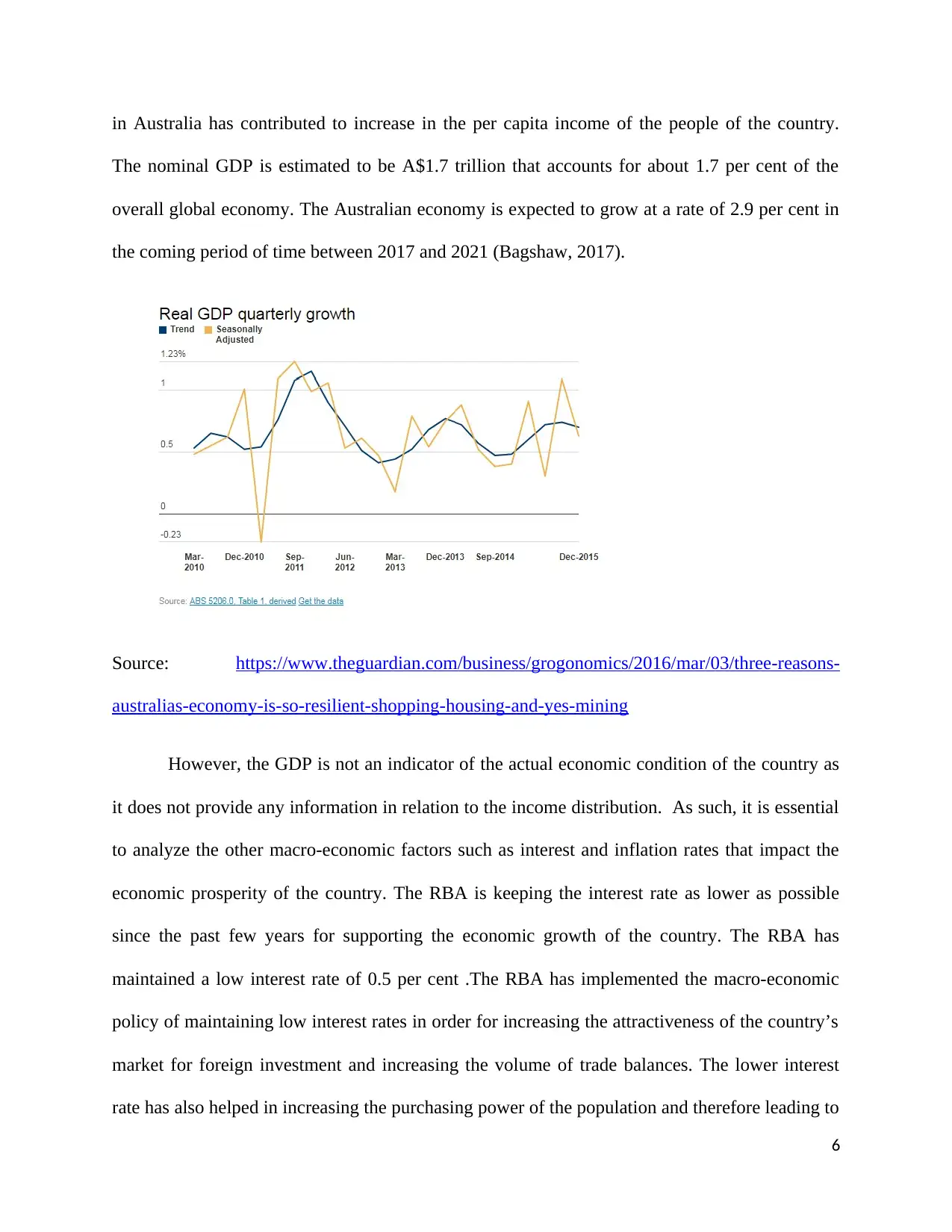
in Australia has contributed to increase in the per capita income of the people of the country.
The nominal GDP is estimated to be A$1.7 trillion that accounts for about 1.7 per cent of the
overall global economy. The Australian economy is expected to grow at a rate of 2.9 per cent in
the coming period of time between 2017 and 2021 (Bagshaw, 2017).
Source: https://www.theguardian.com/business/grogonomics/2016/mar/03/three-reasons-
australias-economy-is-so-resilient-shopping-housing-and-yes-mining
However, the GDP is not an indicator of the actual economic condition of the country as
it does not provide any information in relation to the income distribution. As such, it is essential
to analyze the other macro-economic factors such as interest and inflation rates that impact the
economic prosperity of the country. The RBA is keeping the interest rate as lower as possible
since the past few years for supporting the economic growth of the country. The RBA has
maintained a low interest rate of 0.5 per cent .The RBA has implemented the macro-economic
policy of maintaining low interest rates in order for increasing the attractiveness of the country’s
market for foreign investment and increasing the volume of trade balances. The lower interest
rate has also helped in increasing the purchasing power of the population and therefore leading to
6
The nominal GDP is estimated to be A$1.7 trillion that accounts for about 1.7 per cent of the
overall global economy. The Australian economy is expected to grow at a rate of 2.9 per cent in
the coming period of time between 2017 and 2021 (Bagshaw, 2017).
Source: https://www.theguardian.com/business/grogonomics/2016/mar/03/three-reasons-
australias-economy-is-so-resilient-shopping-housing-and-yes-mining
However, the GDP is not an indicator of the actual economic condition of the country as
it does not provide any information in relation to the income distribution. As such, it is essential
to analyze the other macro-economic factors such as interest and inflation rates that impact the
economic prosperity of the country. The RBA is keeping the interest rate as lower as possible
since the past few years for supporting the economic growth of the country. The RBA has
maintained a low interest rate of 0.5 per cent .The RBA has implemented the macro-economic
policy of maintaining low interest rates in order for increasing the attractiveness of the country’s
market for foreign investment and increasing the volume of trade balances. The lower interest
rate has also helped in increasing the purchasing power of the population and therefore leading to
6
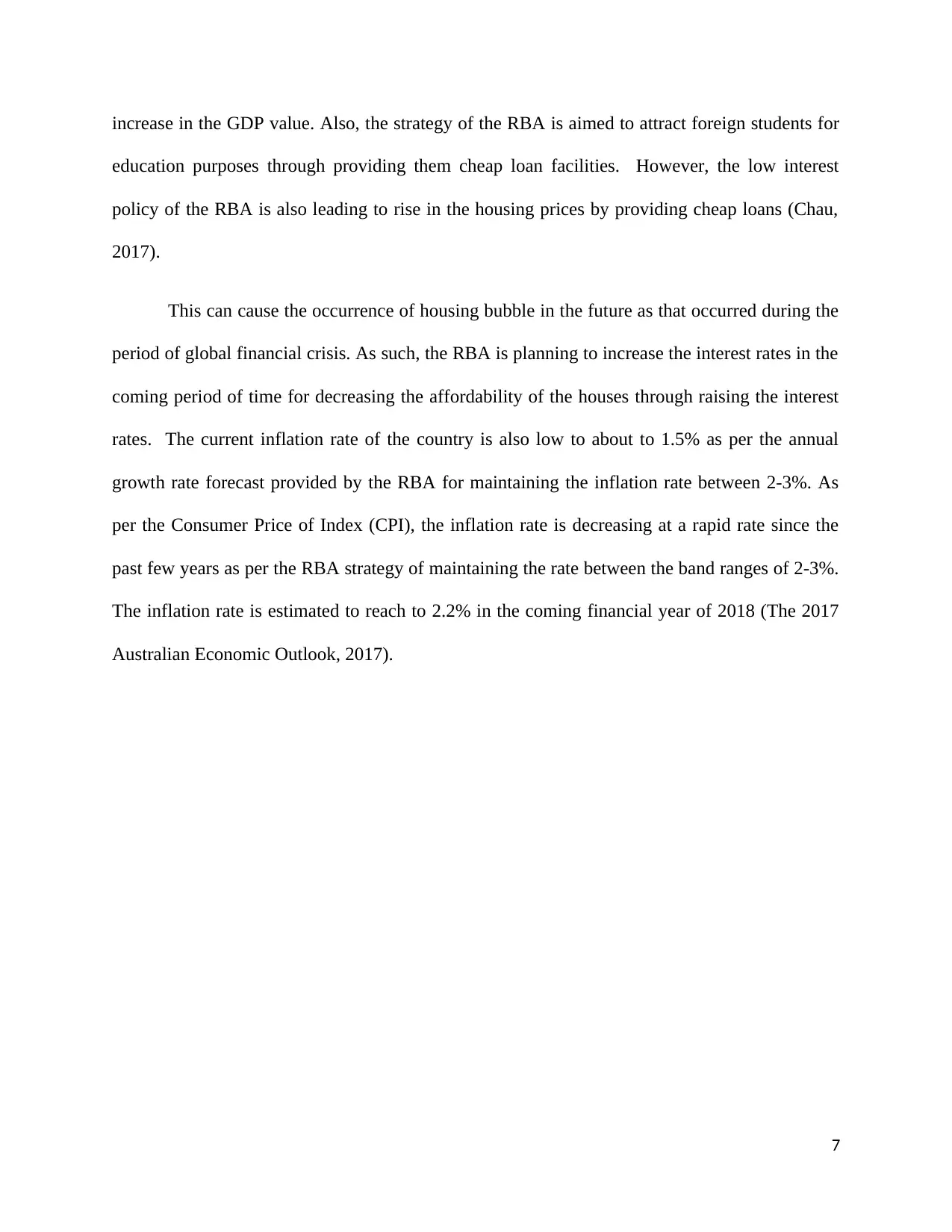
increase in the GDP value. Also, the strategy of the RBA is aimed to attract foreign students for
education purposes through providing them cheap loan facilities. However, the low interest
policy of the RBA is also leading to rise in the housing prices by providing cheap loans (Chau,
2017).
This can cause the occurrence of housing bubble in the future as that occurred during the
period of global financial crisis. As such, the RBA is planning to increase the interest rates in the
coming period of time for decreasing the affordability of the houses through raising the interest
rates. The current inflation rate of the country is also low to about to 1.5% as per the annual
growth rate forecast provided by the RBA for maintaining the inflation rate between 2-3%. As
per the Consumer Price of Index (CPI), the inflation rate is decreasing at a rapid rate since the
past few years as per the RBA strategy of maintaining the rate between the band ranges of 2-3%.
The inflation rate is estimated to reach to 2.2% in the coming financial year of 2018 (The 2017
Australian Economic Outlook, 2017).
7
education purposes through providing them cheap loan facilities. However, the low interest
policy of the RBA is also leading to rise in the housing prices by providing cheap loans (Chau,
2017).
This can cause the occurrence of housing bubble in the future as that occurred during the
period of global financial crisis. As such, the RBA is planning to increase the interest rates in the
coming period of time for decreasing the affordability of the houses through raising the interest
rates. The current inflation rate of the country is also low to about to 1.5% as per the annual
growth rate forecast provided by the RBA for maintaining the inflation rate between 2-3%. As
per the Consumer Price of Index (CPI), the inflation rate is decreasing at a rapid rate since the
past few years as per the RBA strategy of maintaining the rate between the band ranges of 2-3%.
The inflation rate is estimated to reach to 2.2% in the coming financial year of 2018 (The 2017
Australian Economic Outlook, 2017).
7
Paraphrase This Document
Need a fresh take? Get an instant paraphrase of this document with our AI Paraphraser

Source: http://www.abc.net.au/news/2013-07-31/jericho-australias-absurd-interest-rates-debate/
4854044
The RBA has also maintained lower foreign exchange rate for promoting the economic
growth of the country. The value of AUD is on decrease since the past few years and as per the
Australian Bureau of Statistics the value of 1 AUD is about $0.71 USD. The Australian dollar
ahs currently recorded a growth of 0.4 per cent in its value as per the RBA strategy to increase
the interest rates (What makes the Australian dollar move?, 2017). Thus, it can be stated by the
analysis of macro-economic factors of the country that it is highly favorable for investment
purposes. The economic conditions support the industrial development of the country in future
context too thus providing an attractive market for the investors to realize higher capital gains on
their investment. The selected energy industry of Australia has also reported an increase in its
8
4854044
The RBA has also maintained lower foreign exchange rate for promoting the economic
growth of the country. The value of AUD is on decrease since the past few years and as per the
Australian Bureau of Statistics the value of 1 AUD is about $0.71 USD. The Australian dollar
ahs currently recorded a growth of 0.4 per cent in its value as per the RBA strategy to increase
the interest rates (What makes the Australian dollar move?, 2017). Thus, it can be stated by the
analysis of macro-economic factors of the country that it is highly favorable for investment
purposes. The economic conditions support the industrial development of the country in future
context too thus providing an attractive market for the investors to realize higher capital gains on
their investment. The selected energy industry of Australia has also reported an increase in its
8
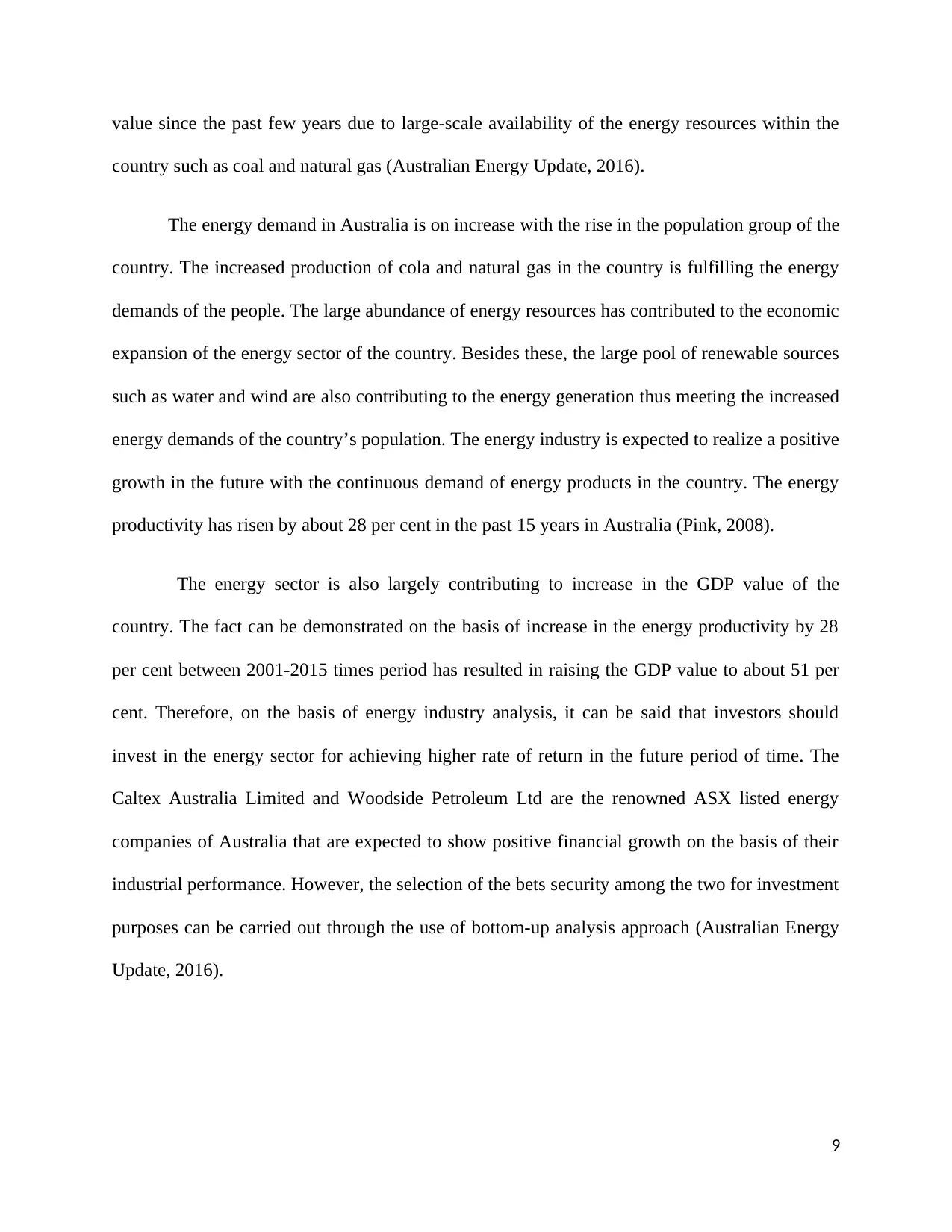
value since the past few years due to large-scale availability of the energy resources within the
country such as coal and natural gas (Australian Energy Update, 2016).
The energy demand in Australia is on increase with the rise in the population group of the
country. The increased production of cola and natural gas in the country is fulfilling the energy
demands of the people. The large abundance of energy resources has contributed to the economic
expansion of the energy sector of the country. Besides these, the large pool of renewable sources
such as water and wind are also contributing to the energy generation thus meeting the increased
energy demands of the country’s population. The energy industry is expected to realize a positive
growth in the future with the continuous demand of energy products in the country. The energy
productivity has risen by about 28 per cent in the past 15 years in Australia (Pink, 2008).
The energy sector is also largely contributing to increase in the GDP value of the
country. The fact can be demonstrated on the basis of increase in the energy productivity by 28
per cent between 2001-2015 times period has resulted in raising the GDP value to about 51 per
cent. Therefore, on the basis of energy industry analysis, it can be said that investors should
invest in the energy sector for achieving higher rate of return in the future period of time. The
Caltex Australia Limited and Woodside Petroleum Ltd are the renowned ASX listed energy
companies of Australia that are expected to show positive financial growth on the basis of their
industrial performance. However, the selection of the bets security among the two for investment
purposes can be carried out through the use of bottom-up analysis approach (Australian Energy
Update, 2016).
9
country such as coal and natural gas (Australian Energy Update, 2016).
The energy demand in Australia is on increase with the rise in the population group of the
country. The increased production of cola and natural gas in the country is fulfilling the energy
demands of the people. The large abundance of energy resources has contributed to the economic
expansion of the energy sector of the country. Besides these, the large pool of renewable sources
such as water and wind are also contributing to the energy generation thus meeting the increased
energy demands of the country’s population. The energy industry is expected to realize a positive
growth in the future with the continuous demand of energy products in the country. The energy
productivity has risen by about 28 per cent in the past 15 years in Australia (Pink, 2008).
The energy sector is also largely contributing to increase in the GDP value of the
country. The fact can be demonstrated on the basis of increase in the energy productivity by 28
per cent between 2001-2015 times period has resulted in raising the GDP value to about 51 per
cent. Therefore, on the basis of energy industry analysis, it can be said that investors should
invest in the energy sector for achieving higher rate of return in the future period of time. The
Caltex Australia Limited and Woodside Petroleum Ltd are the renowned ASX listed energy
companies of Australia that are expected to show positive financial growth on the basis of their
industrial performance. However, the selection of the bets security among the two for investment
purposes can be carried out through the use of bottom-up analysis approach (Australian Energy
Update, 2016).
9
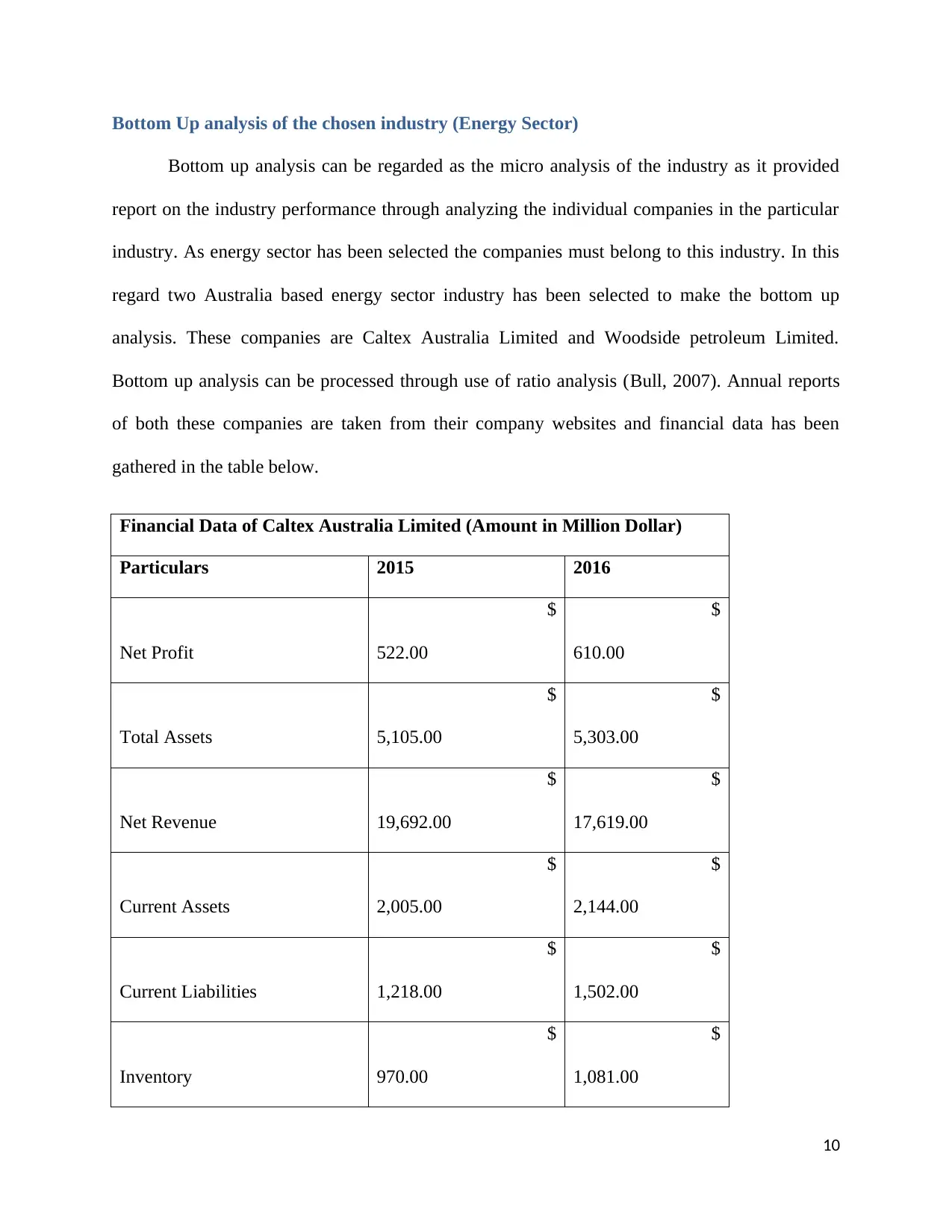
Bottom Up analysis of the chosen industry (Energy Sector)
Bottom up analysis can be regarded as the micro analysis of the industry as it provided
report on the industry performance through analyzing the individual companies in the particular
industry. As energy sector has been selected the companies must belong to this industry. In this
regard two Australia based energy sector industry has been selected to make the bottom up
analysis. These companies are Caltex Australia Limited and Woodside petroleum Limited.
Bottom up analysis can be processed through use of ratio analysis (Bull, 2007). Annual reports
of both these companies are taken from their company websites and financial data has been
gathered in the table below.
Financial Data of Caltex Australia Limited (Amount in Million Dollar)
Particulars 2015 2016
Net Profit
$
522.00
$
610.00
Total Assets
$
5,105.00
$
5,303.00
Net Revenue
$
19,692.00
$
17,619.00
Current Assets
$
2,005.00
$
2,144.00
Current Liabilities
$
1,218.00
$
1,502.00
Inventory
$
970.00
$
1,081.00
10
Bottom up analysis can be regarded as the micro analysis of the industry as it provided
report on the industry performance through analyzing the individual companies in the particular
industry. As energy sector has been selected the companies must belong to this industry. In this
regard two Australia based energy sector industry has been selected to make the bottom up
analysis. These companies are Caltex Australia Limited and Woodside petroleum Limited.
Bottom up analysis can be processed through use of ratio analysis (Bull, 2007). Annual reports
of both these companies are taken from their company websites and financial data has been
gathered in the table below.
Financial Data of Caltex Australia Limited (Amount in Million Dollar)
Particulars 2015 2016
Net Profit
$
522.00
$
610.00
Total Assets
$
5,105.00
$
5,303.00
Net Revenue
$
19,692.00
$
17,619.00
Current Assets
$
2,005.00
$
2,144.00
Current Liabilities
$
1,218.00
$
1,502.00
Inventory
$
970.00
$
1,081.00
10
Secure Best Marks with AI Grader
Need help grading? Try our AI Grader for instant feedback on your assignments.
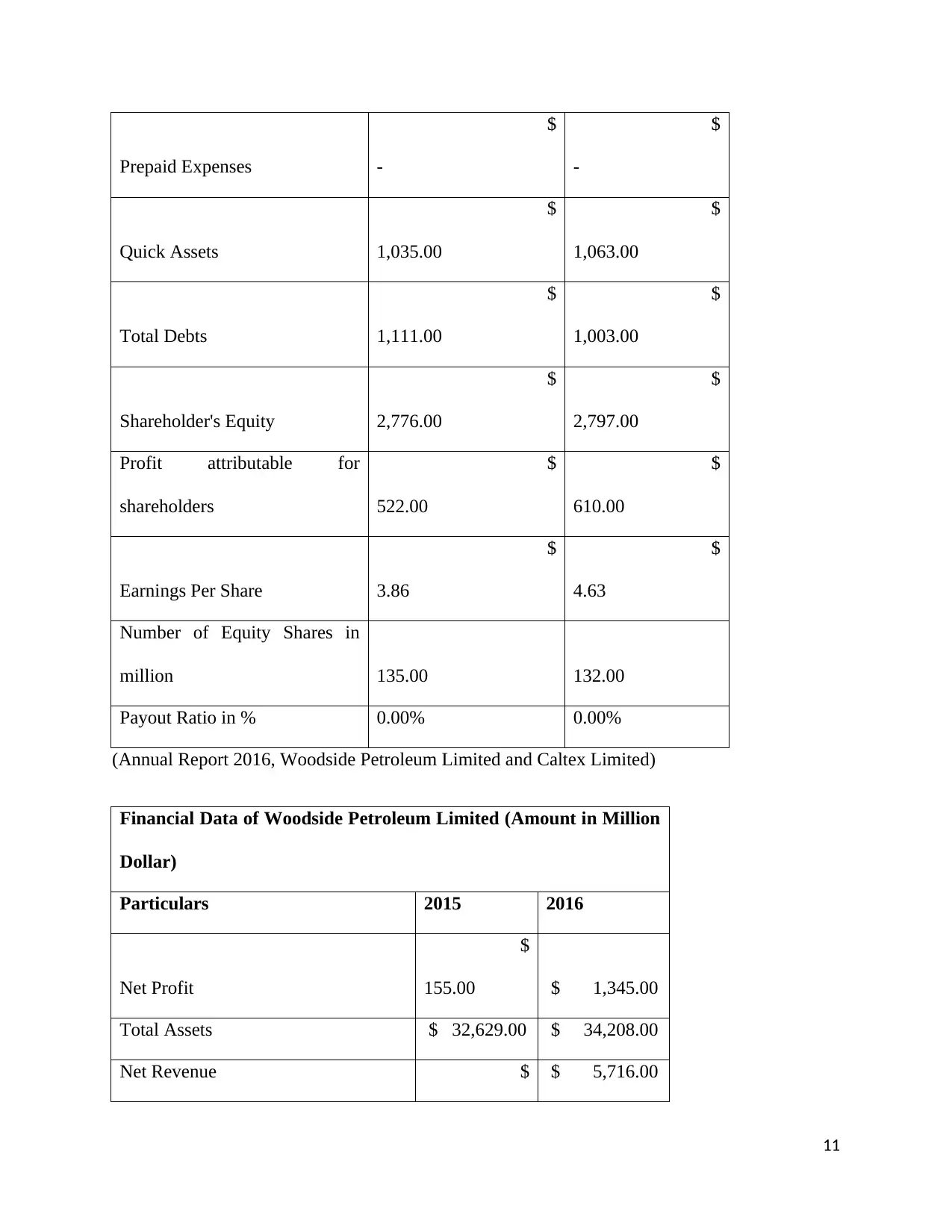
Prepaid Expenses
$
-
$
-
Quick Assets
$
1,035.00
$
1,063.00
Total Debts
$
1,111.00
$
1,003.00
Shareholder's Equity
$
2,776.00
$
2,797.00
Profit attributable for
shareholders
$
522.00
$
610.00
Earnings Per Share
$
3.86
$
4.63
Number of Equity Shares in
million 135.00 132.00
Payout Ratio in % 0.00% 0.00%
(Annual Report 2016, Woodside Petroleum Limited and Caltex Limited)
Financial Data of Woodside Petroleum Limited (Amount in Million
Dollar)
Particulars 2015 2016
Net Profit
$
155.00 $ 1,345.00
Total Assets $ 32,629.00 $ 34,208.00
Net Revenue $ $ 5,716.00
11
$
-
$
-
Quick Assets
$
1,035.00
$
1,063.00
Total Debts
$
1,111.00
$
1,003.00
Shareholder's Equity
$
2,776.00
$
2,797.00
Profit attributable for
shareholders
$
522.00
$
610.00
Earnings Per Share
$
3.86
$
4.63
Number of Equity Shares in
million 135.00 132.00
Payout Ratio in % 0.00% 0.00%
(Annual Report 2016, Woodside Petroleum Limited and Caltex Limited)
Financial Data of Woodside Petroleum Limited (Amount in Million
Dollar)
Particulars 2015 2016
Net Profit
$
155.00 $ 1,345.00
Total Assets $ 32,629.00 $ 34,208.00
Net Revenue $ $ 5,716.00
11
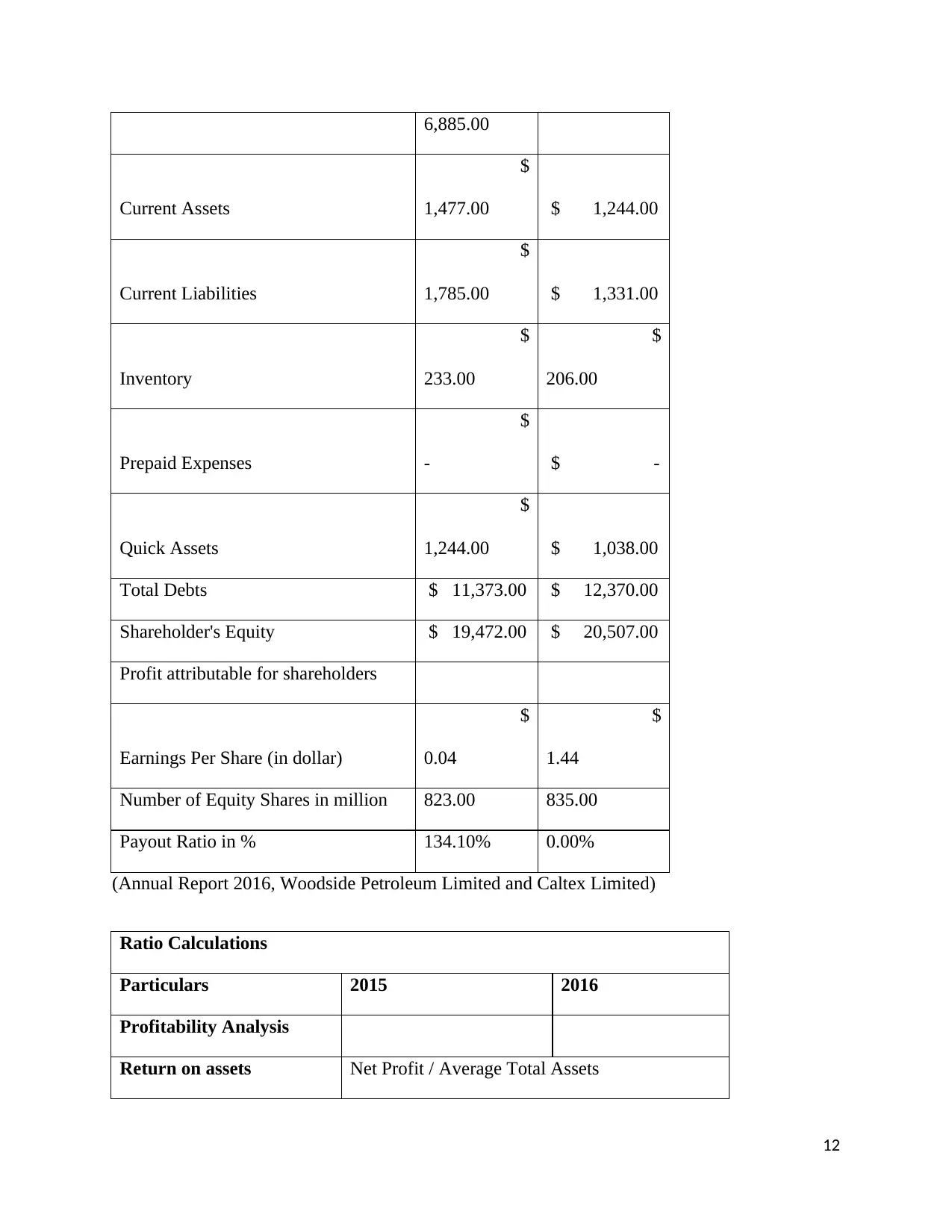
6,885.00
Current Assets
$
1,477.00 $ 1,244.00
Current Liabilities
$
1,785.00 $ 1,331.00
Inventory
$
233.00
$
206.00
Prepaid Expenses
$
- $ -
Quick Assets
$
1,244.00 $ 1,038.00
Total Debts $ 11,373.00 $ 12,370.00
Shareholder's Equity $ 19,472.00 $ 20,507.00
Profit attributable for shareholders
Earnings Per Share (in dollar)
$
0.04
$
1.44
Number of Equity Shares in million 823.00 835.00
Payout Ratio in % 134.10% 0.00%
(Annual Report 2016, Woodside Petroleum Limited and Caltex Limited)
Ratio Calculations
Particulars 2015 2016
Profitability Analysis
Return on assets Net Profit / Average Total Assets
12
Current Assets
$
1,477.00 $ 1,244.00
Current Liabilities
$
1,785.00 $ 1,331.00
Inventory
$
233.00
$
206.00
Prepaid Expenses
$
- $ -
Quick Assets
$
1,244.00 $ 1,038.00
Total Debts $ 11,373.00 $ 12,370.00
Shareholder's Equity $ 19,472.00 $ 20,507.00
Profit attributable for shareholders
Earnings Per Share (in dollar)
$
0.04
$
1.44
Number of Equity Shares in million 823.00 835.00
Payout Ratio in % 134.10% 0.00%
(Annual Report 2016, Woodside Petroleum Limited and Caltex Limited)
Ratio Calculations
Particulars 2015 2016
Profitability Analysis
Return on assets Net Profit / Average Total Assets
12
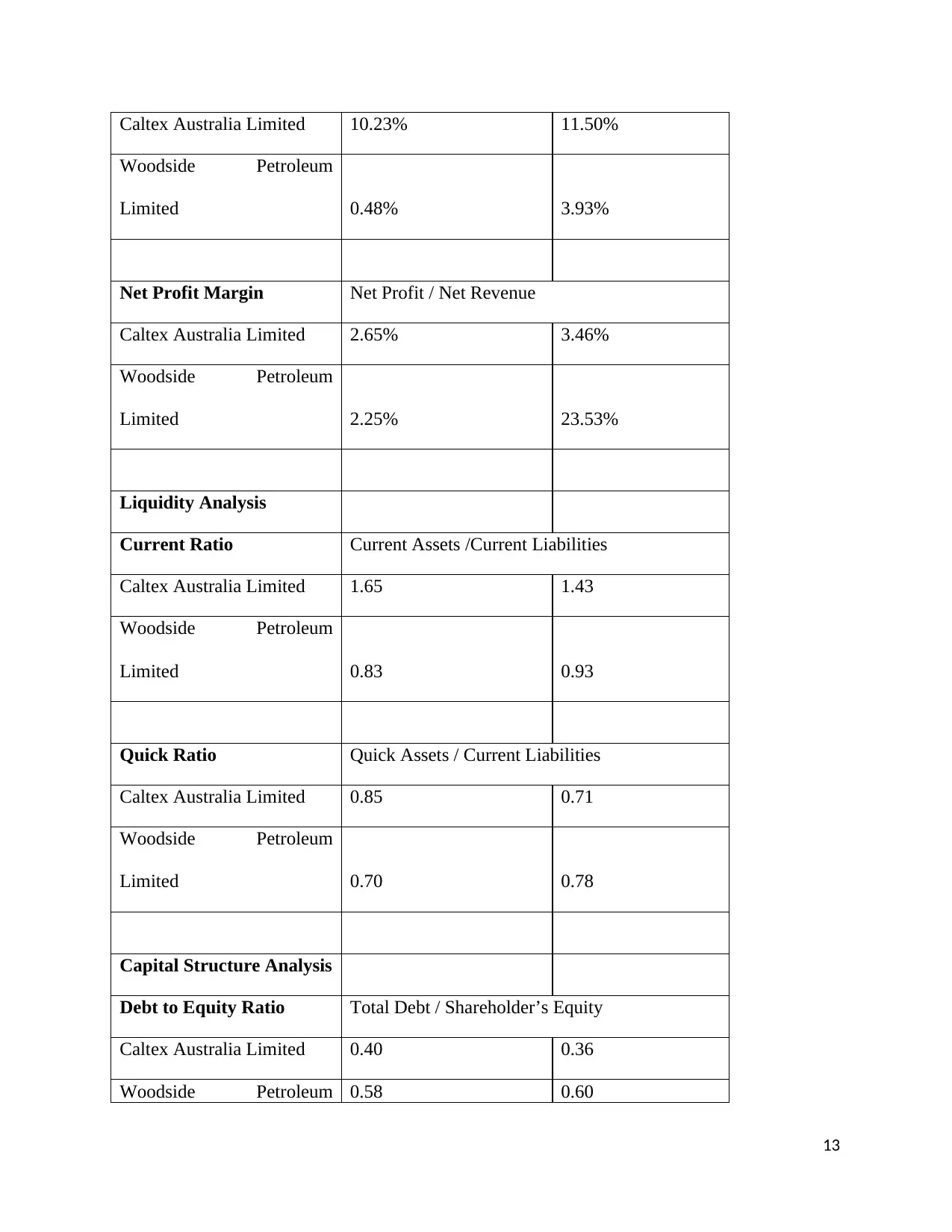
Caltex Australia Limited 10.23% 11.50%
Woodside Petroleum
Limited 0.48% 3.93%
Net Profit Margin Net Profit / Net Revenue
Caltex Australia Limited 2.65% 3.46%
Woodside Petroleum
Limited 2.25% 23.53%
Liquidity Analysis
Current Ratio Current Assets /Current Liabilities
Caltex Australia Limited 1.65 1.43
Woodside Petroleum
Limited 0.83 0.93
Quick Ratio Quick Assets / Current Liabilities
Caltex Australia Limited 0.85 0.71
Woodside Petroleum
Limited 0.70 0.78
Capital Structure Analysis
Debt to Equity Ratio Total Debt / Shareholder’s Equity
Caltex Australia Limited 0.40 0.36
Woodside Petroleum 0.58 0.60
13
Woodside Petroleum
Limited 0.48% 3.93%
Net Profit Margin Net Profit / Net Revenue
Caltex Australia Limited 2.65% 3.46%
Woodside Petroleum
Limited 2.25% 23.53%
Liquidity Analysis
Current Ratio Current Assets /Current Liabilities
Caltex Australia Limited 1.65 1.43
Woodside Petroleum
Limited 0.83 0.93
Quick Ratio Quick Assets / Current Liabilities
Caltex Australia Limited 0.85 0.71
Woodside Petroleum
Limited 0.70 0.78
Capital Structure Analysis
Debt to Equity Ratio Total Debt / Shareholder’s Equity
Caltex Australia Limited 0.40 0.36
Woodside Petroleum 0.58 0.60
13
Paraphrase This Document
Need a fresh take? Get an instant paraphrase of this document with our AI Paraphraser

Limited
Equity Ratio Total Equity / Total Assets
Caltex Australia Limited 54.38% 52.74%
Woodside Petroleum
Limited 59.68% 59.95%
Market Performance
Earnings per Share
Profit attributable for shareholders / Number of
common Stock (Shares)
Caltex Australia Limited
$
3.86
$
4.63
Woodside Petroleum
Limited
$
0.04
$
1.44
Dividend per Share
Total Dividend Distributed / Number of
Common Stock (Shares)
Caltex Australia Limited
$
1.89
$
2.51
Woodside Petroleum
Limited
$
3.94
$
1.50
(Annual Report 2016, Woodside Petroleum Limited and Caltex Limited)
14
Equity Ratio Total Equity / Total Assets
Caltex Australia Limited 54.38% 52.74%
Woodside Petroleum
Limited 59.68% 59.95%
Market Performance
Earnings per Share
Profit attributable for shareholders / Number of
common Stock (Shares)
Caltex Australia Limited
$
3.86
$
4.63
Woodside Petroleum
Limited
$
0.04
$
1.44
Dividend per Share
Total Dividend Distributed / Number of
Common Stock (Shares)
Caltex Australia Limited
$
1.89
$
2.51
Woodside Petroleum
Limited
$
3.94
$
1.50
(Annual Report 2016, Woodside Petroleum Limited and Caltex Limited)
14
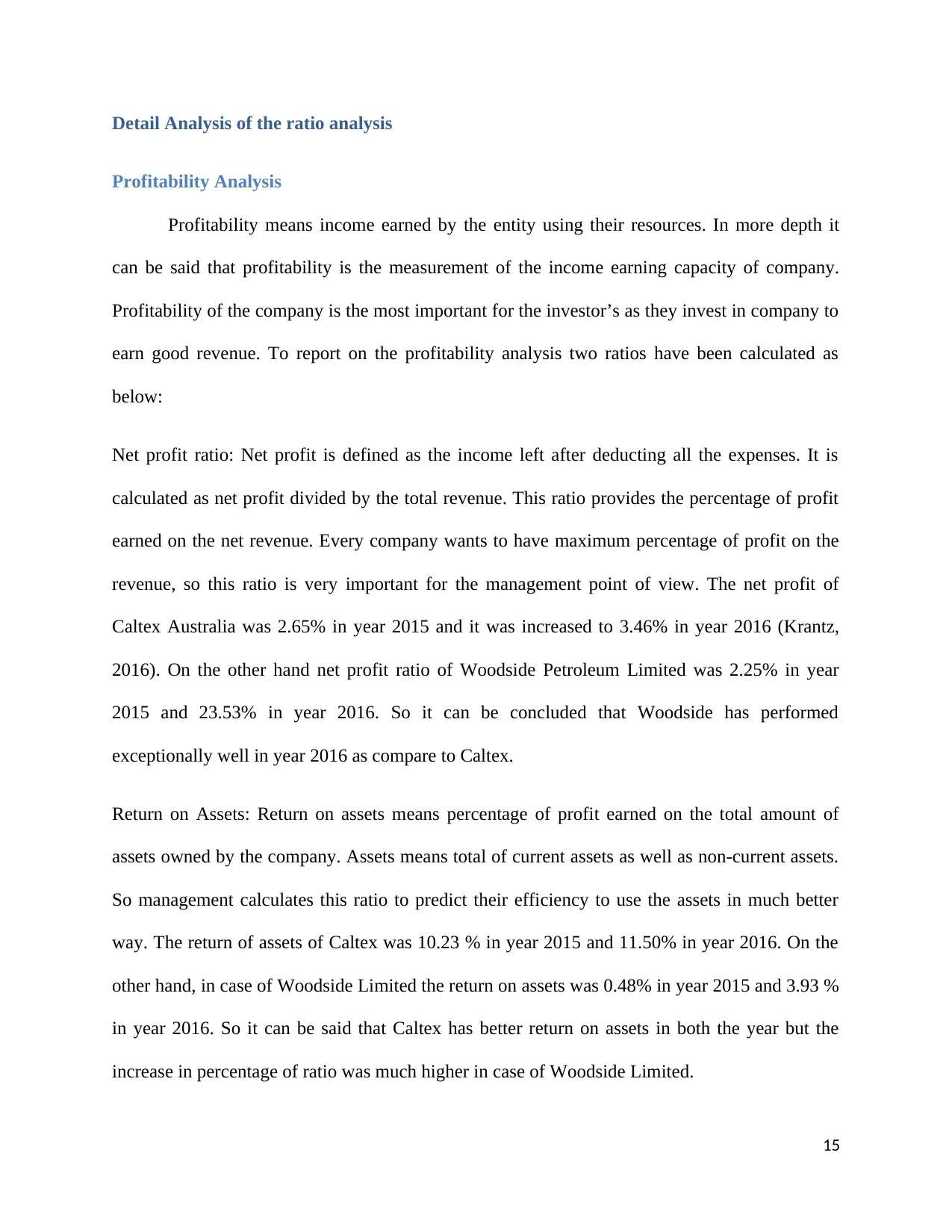
Detail Analysis of the ratio analysis
Profitability Analysis
Profitability means income earned by the entity using their resources. In more depth it
can be said that profitability is the measurement of the income earning capacity of company.
Profitability of the company is the most important for the investor’s as they invest in company to
earn good revenue. To report on the profitability analysis two ratios have been calculated as
below:
Net profit ratio: Net profit is defined as the income left after deducting all the expenses. It is
calculated as net profit divided by the total revenue. This ratio provides the percentage of profit
earned on the net revenue. Every company wants to have maximum percentage of profit on the
revenue, so this ratio is very important for the management point of view. The net profit of
Caltex Australia was 2.65% in year 2015 and it was increased to 3.46% in year 2016 (Krantz,
2016). On the other hand net profit ratio of Woodside Petroleum Limited was 2.25% in year
2015 and 23.53% in year 2016. So it can be concluded that Woodside has performed
exceptionally well in year 2016 as compare to Caltex.
Return on Assets: Return on assets means percentage of profit earned on the total amount of
assets owned by the company. Assets means total of current assets as well as non-current assets.
So management calculates this ratio to predict their efficiency to use the assets in much better
way. The return of assets of Caltex was 10.23 % in year 2015 and 11.50% in year 2016. On the
other hand, in case of Woodside Limited the return on assets was 0.48% in year 2015 and 3.93 %
in year 2016. So it can be said that Caltex has better return on assets in both the year but the
increase in percentage of ratio was much higher in case of Woodside Limited.
15
Profitability Analysis
Profitability means income earned by the entity using their resources. In more depth it
can be said that profitability is the measurement of the income earning capacity of company.
Profitability of the company is the most important for the investor’s as they invest in company to
earn good revenue. To report on the profitability analysis two ratios have been calculated as
below:
Net profit ratio: Net profit is defined as the income left after deducting all the expenses. It is
calculated as net profit divided by the total revenue. This ratio provides the percentage of profit
earned on the net revenue. Every company wants to have maximum percentage of profit on the
revenue, so this ratio is very important for the management point of view. The net profit of
Caltex Australia was 2.65% in year 2015 and it was increased to 3.46% in year 2016 (Krantz,
2016). On the other hand net profit ratio of Woodside Petroleum Limited was 2.25% in year
2015 and 23.53% in year 2016. So it can be concluded that Woodside has performed
exceptionally well in year 2016 as compare to Caltex.
Return on Assets: Return on assets means percentage of profit earned on the total amount of
assets owned by the company. Assets means total of current assets as well as non-current assets.
So management calculates this ratio to predict their efficiency to use the assets in much better
way. The return of assets of Caltex was 10.23 % in year 2015 and 11.50% in year 2016. On the
other hand, in case of Woodside Limited the return on assets was 0.48% in year 2015 and 3.93 %
in year 2016. So it can be said that Caltex has better return on assets in both the year but the
increase in percentage of ratio was much higher in case of Woodside Limited.
15
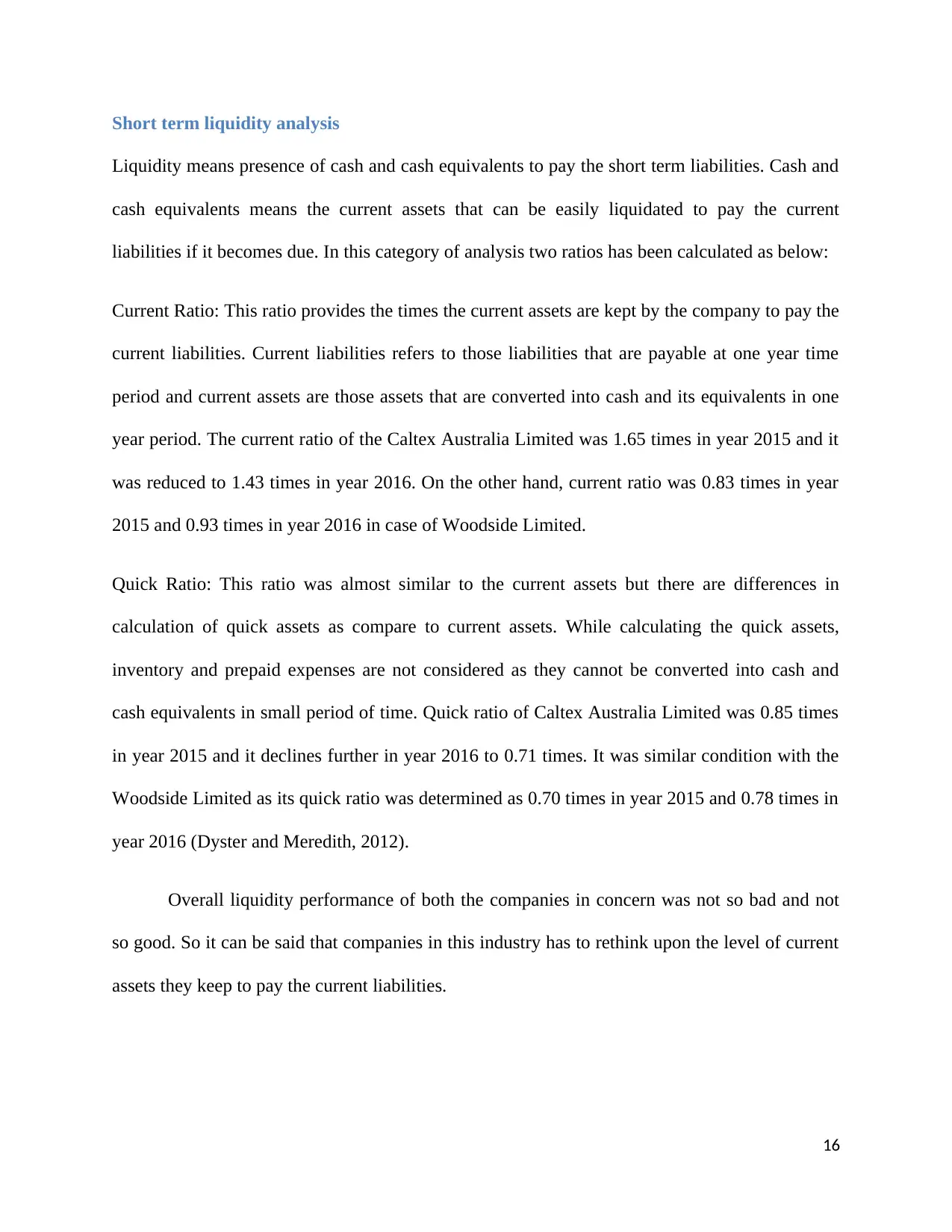
Short term liquidity analysis
Liquidity means presence of cash and cash equivalents to pay the short term liabilities. Cash and
cash equivalents means the current assets that can be easily liquidated to pay the current
liabilities if it becomes due. In this category of analysis two ratios has been calculated as below:
Current Ratio: This ratio provides the times the current assets are kept by the company to pay the
current liabilities. Current liabilities refers to those liabilities that are payable at one year time
period and current assets are those assets that are converted into cash and its equivalents in one
year period. The current ratio of the Caltex Australia Limited was 1.65 times in year 2015 and it
was reduced to 1.43 times in year 2016. On the other hand, current ratio was 0.83 times in year
2015 and 0.93 times in year 2016 in case of Woodside Limited.
Quick Ratio: This ratio was almost similar to the current assets but there are differences in
calculation of quick assets as compare to current assets. While calculating the quick assets,
inventory and prepaid expenses are not considered as they cannot be converted into cash and
cash equivalents in small period of time. Quick ratio of Caltex Australia Limited was 0.85 times
in year 2015 and it declines further in year 2016 to 0.71 times. It was similar condition with the
Woodside Limited as its quick ratio was determined as 0.70 times in year 2015 and 0.78 times in
year 2016 (Dyster and Meredith, 2012).
Overall liquidity performance of both the companies in concern was not so bad and not
so good. So it can be said that companies in this industry has to rethink upon the level of current
assets they keep to pay the current liabilities.
16
Liquidity means presence of cash and cash equivalents to pay the short term liabilities. Cash and
cash equivalents means the current assets that can be easily liquidated to pay the current
liabilities if it becomes due. In this category of analysis two ratios has been calculated as below:
Current Ratio: This ratio provides the times the current assets are kept by the company to pay the
current liabilities. Current liabilities refers to those liabilities that are payable at one year time
period and current assets are those assets that are converted into cash and its equivalents in one
year period. The current ratio of the Caltex Australia Limited was 1.65 times in year 2015 and it
was reduced to 1.43 times in year 2016. On the other hand, current ratio was 0.83 times in year
2015 and 0.93 times in year 2016 in case of Woodside Limited.
Quick Ratio: This ratio was almost similar to the current assets but there are differences in
calculation of quick assets as compare to current assets. While calculating the quick assets,
inventory and prepaid expenses are not considered as they cannot be converted into cash and
cash equivalents in small period of time. Quick ratio of Caltex Australia Limited was 0.85 times
in year 2015 and it declines further in year 2016 to 0.71 times. It was similar condition with the
Woodside Limited as its quick ratio was determined as 0.70 times in year 2015 and 0.78 times in
year 2016 (Dyster and Meredith, 2012).
Overall liquidity performance of both the companies in concern was not so bad and not
so good. So it can be said that companies in this industry has to rethink upon the level of current
assets they keep to pay the current liabilities.
16
Secure Best Marks with AI Grader
Need help grading? Try our AI Grader for instant feedback on your assignments.
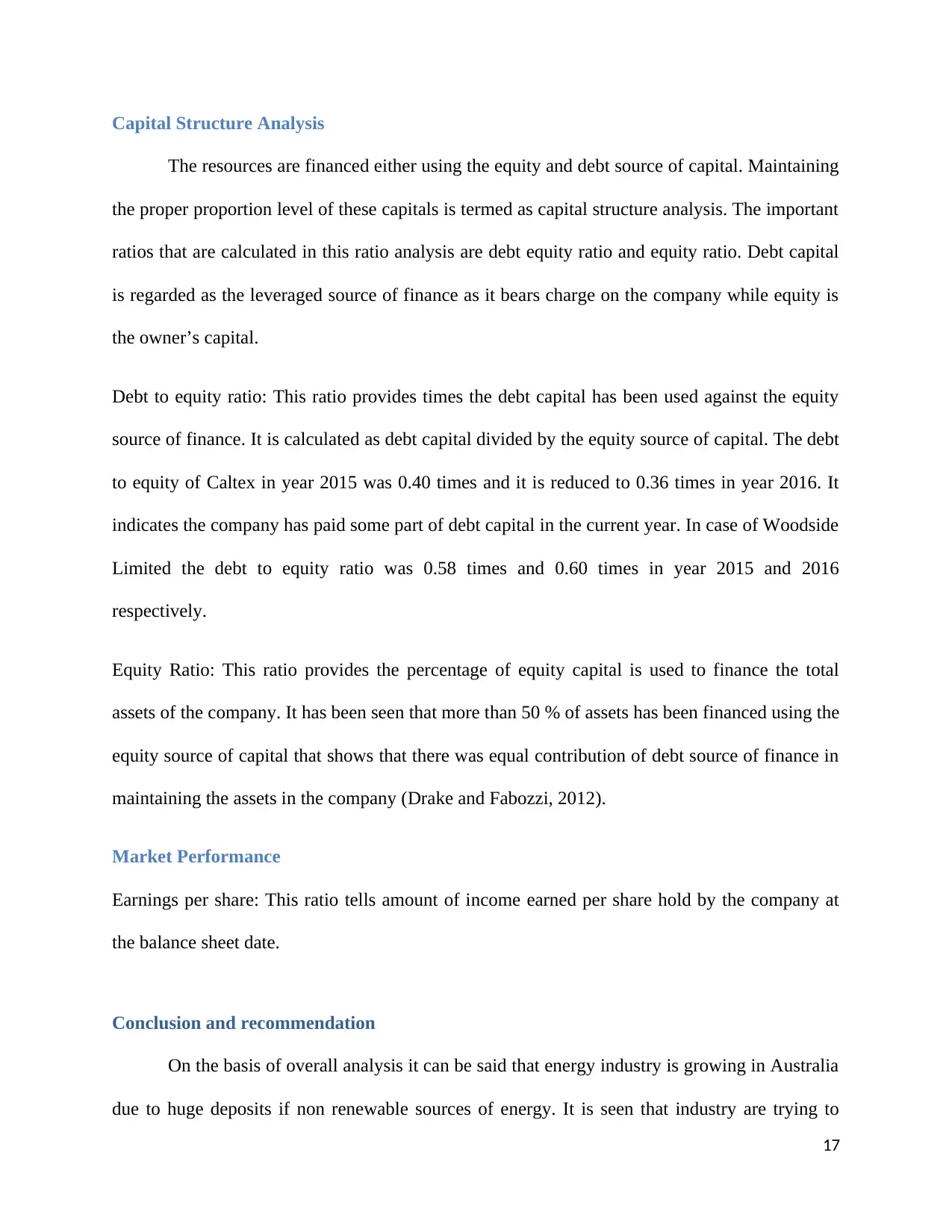
Capital Structure Analysis
The resources are financed either using the equity and debt source of capital. Maintaining
the proper proportion level of these capitals is termed as capital structure analysis. The important
ratios that are calculated in this ratio analysis are debt equity ratio and equity ratio. Debt capital
is regarded as the leveraged source of finance as it bears charge on the company while equity is
the owner’s capital.
Debt to equity ratio: This ratio provides times the debt capital has been used against the equity
source of finance. It is calculated as debt capital divided by the equity source of capital. The debt
to equity of Caltex in year 2015 was 0.40 times and it is reduced to 0.36 times in year 2016. It
indicates the company has paid some part of debt capital in the current year. In case of Woodside
Limited the debt to equity ratio was 0.58 times and 0.60 times in year 2015 and 2016
respectively.
Equity Ratio: This ratio provides the percentage of equity capital is used to finance the total
assets of the company. It has been seen that more than 50 % of assets has been financed using the
equity source of capital that shows that there was equal contribution of debt source of finance in
maintaining the assets in the company (Drake and Fabozzi, 2012).
Market Performance
Earnings per share: This ratio tells amount of income earned per share hold by the company at
the balance sheet date.
Conclusion and recommendation
On the basis of overall analysis it can be said that energy industry is growing in Australia
due to huge deposits if non renewable sources of energy. It is seen that industry are trying to
17
The resources are financed either using the equity and debt source of capital. Maintaining
the proper proportion level of these capitals is termed as capital structure analysis. The important
ratios that are calculated in this ratio analysis are debt equity ratio and equity ratio. Debt capital
is regarded as the leveraged source of finance as it bears charge on the company while equity is
the owner’s capital.
Debt to equity ratio: This ratio provides times the debt capital has been used against the equity
source of finance. It is calculated as debt capital divided by the equity source of capital. The debt
to equity of Caltex in year 2015 was 0.40 times and it is reduced to 0.36 times in year 2016. It
indicates the company has paid some part of debt capital in the current year. In case of Woodside
Limited the debt to equity ratio was 0.58 times and 0.60 times in year 2015 and 2016
respectively.
Equity Ratio: This ratio provides the percentage of equity capital is used to finance the total
assets of the company. It has been seen that more than 50 % of assets has been financed using the
equity source of capital that shows that there was equal contribution of debt source of finance in
maintaining the assets in the company (Drake and Fabozzi, 2012).
Market Performance
Earnings per share: This ratio tells amount of income earned per share hold by the company at
the balance sheet date.
Conclusion and recommendation
On the basis of overall analysis it can be said that energy industry is growing in Australia
due to huge deposits if non renewable sources of energy. It is seen that industry are trying to
17

introduce new way of energy that can boost their existence in the market. So there is huge scope
for new players to make entry and investors also buy or hold their investments and wait to
receive the bugger returns.
18
for new players to make entry and investors also buy or hold their investments and wait to
receive the bugger returns.
18
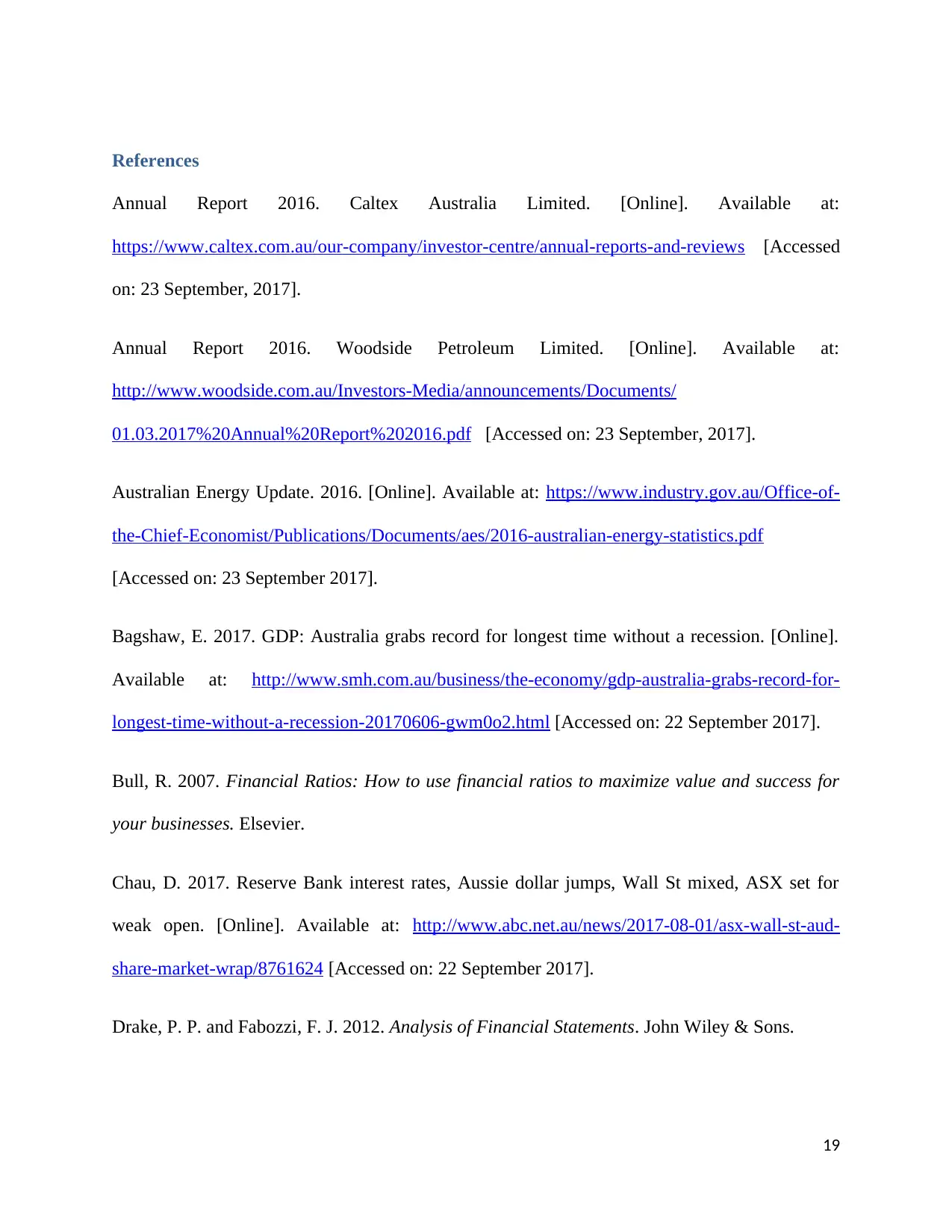
References
Annual Report 2016. Caltex Australia Limited. [Online]. Available at:
https://www.caltex.com.au/our-company/investor-centre/annual-reports-and-reviews [Accessed
on: 23 September, 2017].
Annual Report 2016. Woodside Petroleum Limited. [Online]. Available at:
http://www.woodside.com.au/Investors-Media/announcements/Documents/
01.03.2017%20Annual%20Report%202016.pdf [Accessed on: 23 September, 2017].
Australian Energy Update. 2016. [Online]. Available at: https://www.industry.gov.au/Office-of-
the-Chief-Economist/Publications/Documents/aes/2016-australian-energy-statistics.pdf
[Accessed on: 23 September 2017].
Bagshaw, E. 2017. GDP: Australia grabs record for longest time without a recession. [Online].
Available at: http://www.smh.com.au/business/the-economy/gdp-australia-grabs-record-for-
longest-time-without-a-recession-20170606-gwm0o2.html [Accessed on: 22 September 2017].
Bull, R. 2007. Financial Ratios: How to use financial ratios to maximize value and success for
your businesses. Elsevier.
Chau, D. 2017. Reserve Bank interest rates, Aussie dollar jumps, Wall St mixed, ASX set for
weak open. [Online]. Available at: http://www.abc.net.au/news/2017-08-01/asx-wall-st-aud-
share-market-wrap/8761624 [Accessed on: 22 September 2017].
Drake, P. P. and Fabozzi, F. J. 2012. Analysis of Financial Statements. John Wiley & Sons.
19
Annual Report 2016. Caltex Australia Limited. [Online]. Available at:
https://www.caltex.com.au/our-company/investor-centre/annual-reports-and-reviews [Accessed
on: 23 September, 2017].
Annual Report 2016. Woodside Petroleum Limited. [Online]. Available at:
http://www.woodside.com.au/Investors-Media/announcements/Documents/
01.03.2017%20Annual%20Report%202016.pdf [Accessed on: 23 September, 2017].
Australian Energy Update. 2016. [Online]. Available at: https://www.industry.gov.au/Office-of-
the-Chief-Economist/Publications/Documents/aes/2016-australian-energy-statistics.pdf
[Accessed on: 23 September 2017].
Bagshaw, E. 2017. GDP: Australia grabs record for longest time without a recession. [Online].
Available at: http://www.smh.com.au/business/the-economy/gdp-australia-grabs-record-for-
longest-time-without-a-recession-20170606-gwm0o2.html [Accessed on: 22 September 2017].
Bull, R. 2007. Financial Ratios: How to use financial ratios to maximize value and success for
your businesses. Elsevier.
Chau, D. 2017. Reserve Bank interest rates, Aussie dollar jumps, Wall St mixed, ASX set for
weak open. [Online]. Available at: http://www.abc.net.au/news/2017-08-01/asx-wall-st-aud-
share-market-wrap/8761624 [Accessed on: 22 September 2017].
Drake, P. P. and Fabozzi, F. J. 2012. Analysis of Financial Statements. John Wiley & Sons.
19
1 out of 19
Related Documents
Your All-in-One AI-Powered Toolkit for Academic Success.
+13062052269
info@desklib.com
Available 24*7 on WhatsApp / Email
![[object Object]](/_next/static/media/star-bottom.7253800d.svg)
Unlock your academic potential
© 2024 | Zucol Services PVT LTD | All rights reserved.





